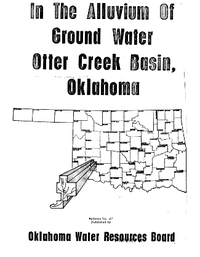Otter Creek basin comprises 287 square miles in Kiowa, Comanche, and Tillman Counties. The basin is not typical of southwestern Oklahoma in that it includes massive mountains and scattered knobs and peaks of the Wichita Mountains. Alluvium covers much of the southern half of the basin but is restricted to the major tributary valleys in the northern half. The upper part of the alluvium is predominantly silt and clay; the lower part is predominantly very fine to medium sand and has a basal stratum of coarse sand and gravel. The average thickness of the flood-plain deposit is about 37 feet. The flood-plain deposits and terrace deposits in the southern part of the basin occur together in the subsurface as an integral unit. Principal recharge to the flood-plain deposits is through infiltration of precipitation and surface runoff, and through percolation from adjoining aquifers, principally the terrace deposits. Principal discharge from the flood-plain deposits is through seepage into Otter Creek by transpiration by vegetation, and by pumping from wells. The city of Snyder pumps about 200,000 gallons per day (gpd) from the alluvium of East Otter Creek during the winter and spring, and about 400,000 gpd during the summer and fall. Irrigation is concentrated principally on the flood plain common to both Otter Creek and North Fork Red River.


